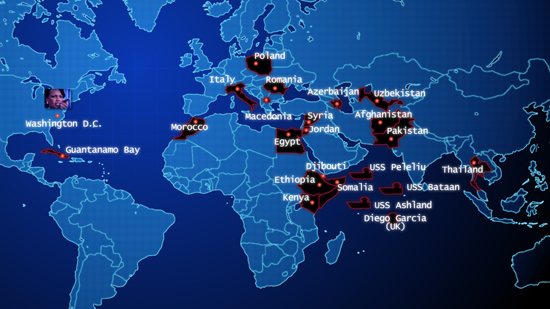By: Alexandra Halsey-Storch
Impunity Watch Reporter, Europe
PARIS, France–On September 6, Thomas Hammarberg, the Commissioner on Human Rights, issued a statement urging European nations—and specifically Romania—to come forth and accept responsibility for a myriad of atrocious human rights violations committed at various black site locations as part of the United States’s War on Terror and the Rendition, Detention and Interrogation (“RDI”) program.

The black sites are “highly secured detention facilities” which harbored “high value detainees” (HVDs) at the height of the War on Terror. After being captured, the most wanted terrorist suspects were detained in a “vast network of clandestine counter-terrorism operations.” These operations were established between “partner agencies across Europe” (and throughout the globe). Each participating country lent their “closest collaboration,” explained Hammarberg.
Once secured at the black sites, detainees were thereafter subjected to “enhanced interrogation” techniques, which “routinely crossed the threshold of cruel, inhuman and degrading treatment, and in many cases consisted of torture.”
Interrogation methods that were used included suffocation by water, prolonged stress standing (naked, with arms extended and chained above one’s head for two to three days at a time), beating and kicking, confinement in a box, which severely restricted movement, prolonged nudity, sleep deprivation, exposure to cold temperatures, and starvation.
Typically, suspected terrorists were moved around to several black site locations during a period of up to four and a half years in order to disorient and confuse the detainee and in an effort to elicit compliance.
Perhaps yet another purpose of the black sites was to mitigate United States accountability. In the “Memorandum for John A. Rizzo,” (“Memorandum”) the United States Department of Justice Office of Legal Council iterated that Article 16 of the United Nations Convention Against Torture and Other Cruel, Inhuman or Degrading Treatment or Punishment applies to conduct within the territory under United States jurisdiction. The Office of Legal Council went on to interpret “jurisdiction” to include, “at most, areas over which the United States exercises at least de facto authority as the government.” The Memorandum further stated that “based on CIA assurances, we understand that the interrogations do not take place in any such areas,” therefore rendering Article 16 inapplicable to said CIA interrogation practices.
Maybe indicative of the highly illegal nature of the black sites, the United States has been determined to keep the locations secret. While CIA officials acknowledge that black sites did in fact exist, they deny violating any laws, and refuse to express much more. As discussed in an article entitled “CIA Holds Terror Suspects in Secret Prisons,” published in 2005 by the Washington Post, the existence and locations of the black sites were, at first, known to only a “handful of officials in the United States and usually, only to the president and a few top intelligence officers in each host country.” Despite recent efforts to uncover the exact locations of all of the black sites, the United States continues to maintain that “details concerning locations” and the “assistance of foreign liaison services in any aspect of the [RDI] program should be kept secret.” Additionally, according to an article issued by CNN, “efforts to challenge the CIA in U.S courts have been turned aside.”
While it remains to be seen how the United States may or may not be implicated under the United Nations Convention, Polish, Romanian, and Lithuanian officials—as convention members—may be held responsible for allowing the CIA to knowingly execute the RDI program and the multitude of human rights violations in their respective countries.
According to Hammarberg, Poland’s black site was opened on December 5, 2002. Between 2002 and 2003, HVDs were held and tortured at this site. While Polish officials were not involved in handling or interrogating detainees, they authorized the occurrences and for that, may be held to some level of accountability under the United Nations Convention.
Furthermore, Hammarberg went on to say that there is significant evidence which shows that Romania’s black site opened on September 23, 2003. Once Poland’s site closed, at least one HVD was brought from Poland to Romania. Romania’s site was open for at least two years. Despite the evidence to the contrary, Romania has continued to deny any wrongdoing; in fact, following Hammarberg’s statement on September 7, Romania’s Foreign Minister expressed to CNN that, “the country has no information whatsoever showing that there existed secret CIA detention centers on its territory.” Perhaps this statement speaks to Hammarberg’s conclusion that Romania has shown “little genuine will to uncover the whole truth.”
Hammarberg also noted that Lithuania—who also held high value detainees in a black site for at least two years—has been complicit in investigations. Lithuania has also demonstrated “intent to reveal the truth through a parliamentary inquiry and a one year pre-trial investigation by the Prosecutor General’s Office.”
Hammarberg concluded, saying that “the full truth must now be established and guarantees given that such forms of co-operation will never be repeated. Effective investigations are imperative and long overdue.”
For more information, please visit:
CNN.com – Council of Europe demands truth on CIA ‘black sites – 6 Sept. 2011
CNN.com – Romania denies hostin secret CIA prisons – 7 Sept. 2011
American Daily Herald – Council of Europe Criticizes U.S. and Partners Over Black Sites and Torture – 8 Sept. 2011
Council of Europe – “Special Review” of Black Sites undertaken by the CIA Inspector General – 5 September 2011
The Irish Times – U.S. Department of Justice Memorandum for John A. Rizzo – 30 May 2005
The Washington Post – CIA Holds Terror Suspects in Secret Prisons – 2 Nov. 2005